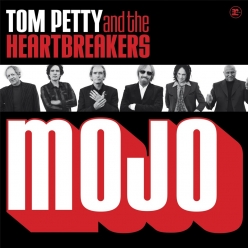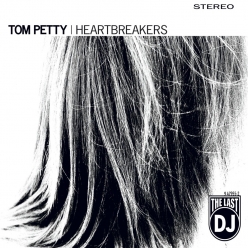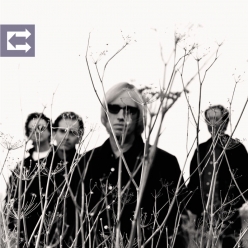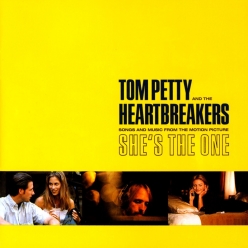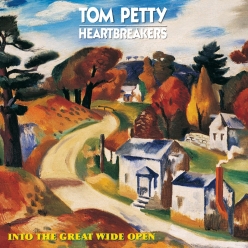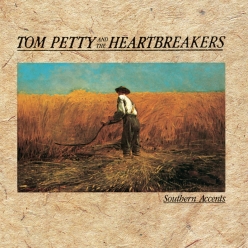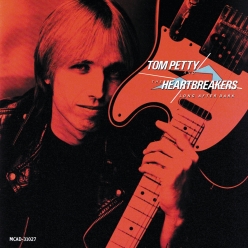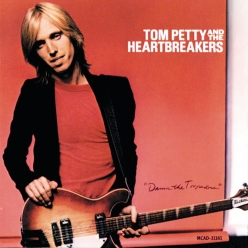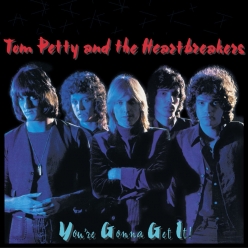Biography
Tom Petty and the Heartbreakers (alternately Tom Petty & The Heartbreakers)[1][2] were an American rock band from Gainesville, Florida. Formed in 1976,[3] the band originally comprised Tom Petty (lead singer, guitar), Mike Campbell (lead guitarist), Ron Blair (bass guitar), Stan Lynch (drums), and Benmont Tench (keyboards). The band largely maintained this lineup, with a few exceptions. In 1981, Blair, tired of the touring lifestyle, left the band. His replacement, Howie Epstein, stayed with the band for the next two decades. In 1991, Scott Thurston joined the band as a multi-instrumentalist—mostly on rhythm guitar and second keyboards. Blair returned to the Heartbreakers in 2002, the year before Epstein's death. In 1994, Steve Ferrone replaced Lynch on drums. The band is best known for the hit singles "American Girl", "Breakdown", "The Waiting", "Learning to Fly", "Refugee" and "Mary Jane's Last Dance".
The band was part of Southern rock[4] but also at the forefront of the heartland rock movement, alongside artists such as Bruce Springsteen, Bob Seger, and John Mellencamp who arose in the late 1970s and 1980s. The genre eschews the synthesizer-based music and fashion elements popular in synthpop and New Romanticism in favor of a straightforward classic rock sound, and lyrics based on relatable, blue collar issues. While the heartland rock movement faded out in the 1990s, the band remained active and popular, touring regularly until Petty's death in 2017, after which the Heartbreakers disbanded. Their final studio album, Hypnotic Eye, was released in 2014.
Although most of their material was produced and performed under the name "The Heartbreakers", Petty released three solo albums, the most successful of which was Full Moon Fever (1989). In these releases, members of the band contributed as collaborators, producing and performing as studio musicians.
Contents 1 History 1.1 Early years and first two albums (1974–1978) 1.2 Mainstream success (1979–1984) 1.3 Southern Accents and Let Me Up (I've Had Enough) (1985–1988) 1.4 Comeback and return to popularity (1989–2005) 1.5 Final years (2006–2017) 1.6 Death of Petty and aftermath (2017–present) 2 Live performances 3 Petty's solo albums 4 Relationship with music industry 5 Band members 6 Discography 7 See also 8 References 9 External links History Early years and first two albums (1974–1978) The band in 1977. From left: Mike Campbell, Ron Blair, Tom Petty, Stan Lynch, and Benmont TenchPetty's early bands included the Sundowners, the Epics, and Mudcrutch. In 1974, Mudcrutch signed with Shelter Records and re-located to Los Angeles, California. They released one single, "Depot Street," in 1975, which failed to chart; the group consequently disbanded.
In 1976, Petty, with himself as lead singer and guitarist, formed "Tom Petty and the Heartbreakers" with Mike Campbell (lead guitarist), Ron Blair (bass), Stan Lynch (drums), and Benmont Tench (keyboards).[3] The Heartbreakers began their recording career with a self-titled album, released through the Shelter label. Initially, the Heartbreakers did not gain much traction in the US, although they achieved success in the UK playing "Anything That's Rock 'n' Roll" on Top of the Pops.[5] Early singles included "Breakdown" and "American Girl". Recalling the band's first gig in the UK in 1976, Petty states, "The audience just jumped up and charged the stage and were boogieing their brains out. It was such a rush. Wow, we had never seen anything like that, man.”[5] "Breakdown" was re-released in the U.S. and became a Top 40 hit in 1978, after word filtered back of the band's massive success in the UK, and perhaps more importantly after it featured on the extremely popular soundtrack to the 1978 film, FM. "American Girl" was covered in 1977 by Roger McGuinn on his "Thunderbyrd" LP.
Tom Petty and the Heartbreakers' second album, You're Gonna Get It! (1978), was their first gold record, and featured the singles "I Need to Know" and "Listen To Her Heart". In 1979, the band was dragged into a legal dispute when ABC Records, Shelter's distributor, was sold to MCA Records. Petty refused to be transferred to another record label. He held fast to his principles, which led to his filing for bankruptcy as a tactic against MCA.
Mainstream success (1979–1984)In 1979, after their legal dispute was settled, the Heartbreakers released their third album Damn the Torpedoes through MCA's Backstreet label. The album rapidly went platinum. It included "Don't Do Me Like That" (#10 U.S., the group's first Top Ten single) and "Refugee" (#15 U.S.), their U.S. breakthrough singles.
Though he was already extremely successful, Petty ran into record company trouble again when he and the Heartbreakers prepared to release Hard Promises (1981), the follow-up album to Damn the Torpedoes. MCA wanted to release the record at the list price of $9.98, which was considered a high price for a record album at the time. This so-called "superstar pricing" was $1.00 more than the usual list price of $8.98. Petty voiced his objections to the price hike in the press, and the issue became a popular cause among music fans. Non-delivery of the album or naming it Eight Ninety-Eight were considered, but eventually MCA decided against the price increase. The album became a Top Ten hit, going platinum and spawning the hit single "The Waiting" (#19 U.S.). The album also included the duet "Insider", with Stevie Nicks.
On their fifth album, Long After Dark (1982), bass player Ron Blair was replaced by Howie Epstein (formerly of Del Shannon's backing band), giving the Heartbreakers their line-up until 1991. Long After Dark features the hits "You Got Lucky" (U.S. #20) and "Change of Heart" (U.S. #21), and was to feature a track called "Keeping Me Alive", but producer Jimmy Iovine vetoed it from the album. Petty has expressed that he feels the album would have turned out better if the song had been included on the album.[citation needed]
Southern Accents and Let Me Up (I've Had Enough) (1985–1988)On the sixth album, Southern Accents (1985), the Heartbreakers picked up where they had left off.[clarification needed] The recording was not without problems; Petty became frustrated during the mixing process and broke his left hand when punching a wall. The album includes the psychedelic-sounding hit single "Don't Come Around Here No More" (#13 U.S.), which was produced by and co-written with Dave Stewart. The video for the single, which starred Stewart, featured Petty dressed as the Mad Hatter, mocking and chasing Alice from the book Alice's Adventures in Wonderland, then cutting and eating her as if she were a cake. This caused minor controversy after it was criticized by feminist groups,[citation needed] but the video did win an MTV Video Music Award.
A successful concert tour led to the live album Pack Up the Plantation: Live! (1985). The band's live capabilities were also showcased when Bob Dylan invited the Heartbreakers to join him on his True Confessions Tour through Australia, Japan and the U.S. (1986) and Europe (1987). Petty praised Dylan, saying "I don't think there is anyone we admire more."
Also in 1987, the group released Let Me Up (I've Had Enough), a studio album made to sound like a live recording, using a technique they borrowed from Dylan. It includes "Jammin' Me" (#18 U.S.), which Petty wrote with Dylan and Campbell. Dylan recorded a version of the Petty composition, "Got My Mind Made Up", on his album Knocked Out Loaded.
Comeback and return to popularity (1989–2005)In 1989, Petty released his debut solo album Full Moon Fever, which included five singles ("I Won't Back Down", "Runnin' Down a Dream", "Free Fallin'", "A Face in the Crowd" and "Yer So Bad"), and was accompanied by a tour with The Replacements. Two years later, the Heartbreakers released Into the Great Wide Open, produced by Jeff Lynne who had worked with Petty in Traveling Wilburys. Songs included the title track itself and "Learning to Fly". Multi-instrumentalist Scott Thurston joined the band as of the tour for the album.
Hollywood walk of fame star, awarded in 1999In 1993, Petty released Greatest Hits which included the hit single "Mary Jane's Last Dance". Stan Lynch had moved to Florida, but was persuaded to return for his last session with the band.
In 1994, Lynch left the band and was temporarily replaced by Dave Grohl before being permanently replaced by Steve Ferrone. Ferrone had worked with Petty, Campbell, Tench, and Epstein on Petty's solo album, Wildflowers. At this time, the band served as backing band on Unchained by Johnny Cash with producer Rick Rubin.
In 1995, a six-CD box-set entitled Playback was released. Approximately half of the tracks were previously available on albums, and the rest were B-sides, demos and live tracks. Two notable tracks are a "solo" version of Tom's 1981 duet with Stevie Nicks, "Stop Draggin' My Heart Around", and the song "Waiting For Tonight", which features vocals from The Bangles. The latter song also appeared on the two-CD anthology released in 2000, Anthology: Through the Years.
In 1996, Petty "reunited" with the Heartbreakers and released a soundtrack to the movie She's the One starring Cameron Diaz and Jennifer Aniston (see Songs and Music from "She's the One"). Three songs charted from this album; these were "Walls (Circus)" (featuring Lindsey Buckingham); "Climb that Hill"; and a song written by Lucinda Williams, "Change the Locks". The album also included a cover of a song by Beck, "Asshole".
In 1999, Petty and the Heartbreakers released the album Echo with producer Rick Rubin at the helm. The album reached number 10 in the U.S. album charts and featured, amongst other singles, "Room at the Top".
On April 28, 1999, Tom Petty & the Heartbreakers received a star on the Hollywood Walk of Fame for their contributions to the recording industry, located at 7018 Hollywood Boulevard.[6]
In 2002, the group released The Last DJ. Many of the tracks' lyrics contain stinging attacks on the music industry and major record companies. The album reached number 9 in the U.S. charts. Ron Blair played on two of the tracks. He also replaced the man who had previously been his replacement, Howie Epstein on the band's 2002 tour as a result of Epstein's deepening personal problems and drug abuse. Epstein died in 2003 at the age of 47. Tench described him as "the coolest guy in the band."
Final years (2006–2017) Keyboardist Benmont Tench performs with the band at the Hollywood Bowl in 2010.In the band's thirtieth anniversary year, 2006, they headlined the fifth annual Bonnaroo Music and Arts Festival. In addition to Bonnaroo, Petty was on tour throughout the summer of 2006. The tour started in Charlotte, North Carolina on June 9 and ended in Randall's Island, Manhattan, New York on August 19. Stops included major cities such as New York, St. Louis, Indianapolis, and Denver. Supporting acts during the tour included Pearl Jam, The Allman Brothers Band, and Trey Anastasio. Additionally, Stevie Nicks joined the band onstage during the first eight concerts as well as subsequent second leg dates to perform various songs from the Heartbreakers' vast catalog. For the Highway Companion Tour they offered a Highway Companion's Club which allowed fans to receive priority seating, discounts at the Tom Petty Store, a complimentary CD of Highway Companion and a personalized email address.
In 2006, the ABC U.S. television network hired Petty to do the music for its NBA Playoffs coverage.
On September 21, 2006, Tom Petty and the Heartbreakers received the keys to the city of Gainesville, Florida, where he and his bandmates either lived or grew up. Petty quipped, when questioned about the key he received from Gainesville's mayor, "It's a lot nicer than the one we got in Chicago."[7]
From July 2006 until 2007, the Rock and Roll Hall of Fame in Cleveland, Ohio featured an exhibit of Tom Petty items. Much of the content was donated by Petty himself from a visit to his home by some of the Rock Hall curatorial staff.
In 2007, the band accepted an invitation to participate in a tribute album to Fats Domino, contributing their version of "I'm Walkin'" to Goin' Home: A Tribute to Fats Domino (Vanguard).
In 2008, the Heartbreakers were also featured as the Super Bowl XLII Halftime Show. In April that year, the members of Petty's prior band, Mudcrutch, including Heartbreakers Petty, Benmont Tench and Mike Campbell, along with Randall Marsh and Tom Leadon, released a Mudcrutch album. In late 2008, Mudcrutch released a live EP.
A collection of live recordings was released on November 23, 2009, and announced a new studio album, Mojo, for release in the Spring of 2010.[8] The band released Hypnotic Eye on July 29, 2014, and archive recordings from their Playlist box set Nobody's Children and Through the Cracks digitally in 2015.
In 2017, the band embarked on a 40th Anniversary Tour of the United States.[9] The tour began on April 20 in Oklahoma City, Oklahoma and ended on September 25 with a performance at the Hollywood Bowl in Hollywood, California.[9][10] The Hollywood Bowl concert, which would ultimately be the Heartbreakers' final show, ended with a performance of "American Girl".[11]
Death of Petty and aftermath (2017–present)Early in the morning on October 2, 2017, Petty was found unconscious in his home, not breathing, and in full cardiac arrest. Following premature media reports of his death, Petty later died at the UCLA Medical Center in Santa Monica, California. He was 66.[12][13]
No official statement about the disbandment or the future of the Heartbreakers was made immediately following Petty's death. However, in his final interview with the Los Angeles Times a few days before his death, Petty expressed that the Heartbreakers would probably disband if one of its members died or became too ill to perform.[14]
In April 2018, Campbell, Tench and Ferrone acted as the backing band for the Light Up the Blues benefit concert in Los Angeles, backing Beck, Patti Smith, and Stephen Stills, with whom they performed Petty's "I Won't Back Down".[15] That same month, it was announced that Campbell (along with Neil Finn) had joined Fleetwood Mac to replace their lead guitarist Lindsey Buckingham.[16]
Live performances Mike Campbell (left) and Tom Petty at Bonnaroo in 2013 This section needs expansion. You can help by adding to it. (May 2016)
-505x284.jpg)
